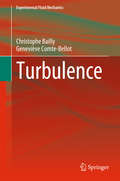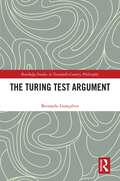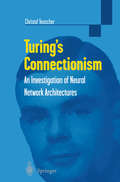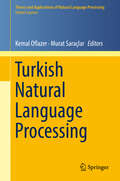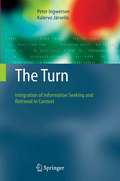- Table View
- List View
Turbo Prolog — Einführung in die Anwendung (Programmieren von Mikrocomputern #29)
by Konrad JustenDie Künstliche Intelligenz befaßt sich mit der Nachbildung von intelligentem mensch lichen Verhalten durch Computer. Eines ihrer Teilgebiete ist das Automatische Beweisen, wo die Tätigkeit des Beweisens mathematischer Aussagen, die Tätigkeit von Mathematikern also, simuliert werden soll. Hier stellt man sich die Frage, ob eine Formel (eine Aussage, ein Satz) der Prädikatenlogik aus gewissen vorgegebenen Formeln mechanisch, durch ein Computerprogramm, ableitbar ist. Ein Prolog-Interpreter oder -Compiler (ein Prolog-System) kann aufgefaßt werden als ein solches Ableitungs- oder Beweisprogramm, als ein Inferenzmechanismus, das Prolog Programm selbst als eine Reihe vorgegebener Formeln, als Wissensbasis. Prolog ist ein dialogorientes System: Der Benutzer stellt ein Problem, eine Frage (zu einer Wissensbasis) und erhält eine Antwort, nachdem das Inferenzverfahren die Ableit barkeit aus der Wissensbasis untersucht hat, usw. Prolog ist eine deskriptive (deklarative) Programmiersprache. Ein Programm in Prolog beschreibt ein Problem nur, nennt nur seine Grundregeln und -bedingungen, gibt nur das Problemwissen an. Es schreibt nicht - wie das in konventionellen Programmier sprachen der Fall ist - Schritt für Schritt vor, wie man mit Hilfe des Problemwissens zu einer Problemlösung gelangt. Ein Wissensbasiertes System ist ein Problemlösungsprogramm, das als Komponenten mindestens eine Wissensbasis und einen Inferenzmechanismus beinhaltet. Danach können wir jedes Prolog-Programm zusammen mit seinem Interpreter oder Compiler als Wissensbasiertes System auffassen: Das Programm bildet die Wissensbasis, und das Prolog-System liefert den Inferenzmechanismus. Ein Expertensystem ist ein Wissensbasiertes System, das die Problemlösefahigkeit eines Experten simuliert.
Turbocharger Integration into Multidimensional Engine Simulations to Enable Transient Load Cases (Wissenschaftliche Reihe Fahrzeugtechnik Universität Stuttgart)
by Andreas KächeleDespite the increasing interest in multidimensional combustion engine simulation from researchers and industry, the field of application has been restricted to stationary operating points for turbocharged engines. Andreas Kächele presents a 3D-CFD approach to extend the simulation into the transient regime, enabling the detailed analysis of phenomena during changes in engine operating point. The approach is validated by means of a virtual hot gas test bench and experiments on a two-cylinder engine.
Turbomachinery Flow Physics and Dynamic Performance
by Meinhard T. SchobeiriOver the past three decades turbomachines experienced a steep increase in efficiency and performance. Based on fundamental principles of turbomachinery thermo-fluid mechanics, numerous CFD based calculation methods are being developed to simulate the complex 3-dimensional, highly unsteady turbulent flow within turbine or compressor stages. The objective of this book is to present the fundamental principals of turbomachinery fluid-thermodynamic design process of turbine and compressor components, power generation and aircraft gas turbines in a unified and compact manner. The book provides senior undergraduate students, graduate students and engineers in the turbomachinery industry with a solid background of turbomachinery flow physics and performance fundamentals that are essential for understanding turbomachinery performance and flow complexes.
Turbulence (Experimental Fluid Mechanics)
by Christophe Bailly Geneviève Comte-BellotThis book covers the major problems of turbulence and turbulent processes, including physical phenomena, their modeling and their simulation.After a general introduction in Chapter 1 illustrating many aspects dealing with turbulent flows, averaged equations and kinetic energy budgets are provided in Chapter 2. The concept of turbulent viscosity as a closure of the Reynolds stress is also introduced. Wall-bounded flows are presented in Chapter 3 and aspects specific to boundary layers and channel or pipe flows are also pointed out. Free shear flows, namely free jets and wakes, are considered in Chapter 4. Chapter 5 deals with vortex dynamics. Homogeneous turbulence, isotropy and dynamics of isotropic turbulence are presented in Chapters 6 and 7. Turbulence is then described both in the physical space and in the wave number space. Time dependent numerical simulations are presented in Chapter 8, where an introduction to large eddy simulation is offered. The last three chapters of the book summarize remarkable digital techniques current and experimental. Many results are presented in a practical way, based on both experiments and numerical simulations.The book is written for a advanced engineering students as well as postgraduate engineers and researchers. For students, it contains the essential results as well as details and demonstrations whose oral transmission is often tedious. At a more advanced level, the text provides numerous references which allow readers to find quickly further study regarding their work and to acquire a deeper knowledge on topics of interest.
Turbulence and Interactions: Proceedings of the TI 2012 conference (Notes on Numerical Fluid Mechanics and Multidisciplinary Design #125)
by Michel O. Deville Jean-Luc Estivalezes Vincent Gleize Thien-Hiep Lê Marc Terracol Stéphane VincentThe book presents a snapshot of the state-of-art in the field of turbulence modeling and covers the latest developments concerning direct numerical simulations, large eddy simulations, compressible turbulence, coherent structures, two-phase flow simulation and other related topics. It provides readers with a comprehensive review of both theory and applications, describing in detail the authors’ own experimental results. The book is based on the proceedings of the third Turbulence and Interactions Conference (TI 2012), which was held on June 11-14 in La Saline-les-Bains, La Réunion, France and includes both keynote lectures and outstanding contributed papers presented at the conference. This multifaceted collection, which reflects the conference´s emphasis on the interplay of theory, experiments and computing in the process of understanding and predicting the physics of complex flows and solving related engineering problems, offers a practice-oriented guide for students, researchers and professionals in the field of computational fluid dynamics, turbulence modeling and related areas.
Turbulence in Fluids (Fluid Mechanics and Its Applications #84)
by Marcel LesieurNow in its fully updated fourth edition, this leading text in its field is an exhaustive monograph on turbulence in fluids in its theoretical and applied aspects. The authors examine a number of advanced developments using mathematical spectral methods, direct-numerical simulations, and large-eddy simulations. The book remains a hugely important contribution to the literature on a topic of great importance for engineering and environmental applications, and presents a very detailed presentation of the field.
Turbulence Nature and the Inverse Problem (Fluid Mechanics and Its Applications #89)
by L. N. PyatnitskyHydrodynamic equations well describe averaged parameters of turbulent steady flows, at least in pipes where boundary conditions can be estimated. The equations might outline the parameters fluctuations as well, if entry conditions at current boundaries were known. This raises, in addition, the more comprehensive problem of the primary perturbation nature, noted by H.A. Lorentz, which still remains unsolved. Generally, any flow steadiness should be supported by pressure waves emitted by some external source, e.g. a piston or a receiver. The wave plane front in channels quickly takes convex configuration owing to Rayleigh's law of diffraction divergence. The Schlieren technique and pressure wave registration were employed to investigate the wave interaction with boundary layer, while reflecting from the channel wall. The reflection induces boundary-layer local separation and following pressure rapid increase within the perturbation zone. It propagates as an acoustic wave packet of spherical shape, bearing oscillations of hydrodynamic parameters. Superposition of such packets forms a spatio-temporal field of oscillations fading as 1/r. This implies a mechanism of the turbulence. Vorticity existing in the boundary layer does not penetrate in itself into potential main stream. But the wave leaving the boundary layer carries away some part of fluid along with frozen-in vorticity. The vorticity eddies form another field of oscillations fading as 1/r2. This implies a second mechanism of turbulence. Thereupon the oscillation spatio-temporal field and its randomization development are easy computed. Also, normal burning transition into detonation is explained, and the turbulence inverse problem is set and solved as applied to plasma channels created by laser Besselian beams.
Turbulence Structure and Modulation (CISM International Centre for Mechanical Sciences #415)
by Alfredo Soldati Rosesella MontiControlling turbulence is an important issue for a number of technological applications. Several methods to modulate turbulence are currently being investigated. This book describes various aspects of turbulence structure and modulation, and explains and discusses the most promising techniques in detail.
Turing Computability: Theory and Applications (Theory and Applications of Computability)
by Robert I. SoareTuring's famous 1936 paper introduced a formal definition of a computing machine, a Turing machine. This model led to both the development of actual computers and to computability theory, the study of what machines can and cannot compute. This book presents classical computability theory from Turing and Post to current results and methods, and their use in studying the information content of algebraic structures, models, and their relation to Peano arithmetic. The author presents the subject as an art to be practiced, and an art in the aesthetic sense of inherent beauty which all mathematicians recognize in their subject. Part I gives a thorough development of the foundations of computability, from the definition of Turing machines up to finite injury priority arguments. Key topics include relative computability, and computably enumerable sets, those which can be effectively listed but not necessarily effectively decided, such as the theorems of Peano arithmetic. Part II includes the study of computably open and closed sets of reals and basis and nonbasis theorems for effectively closed sets. Part III covers minimal Turing degrees. Part IV is an introduction to games and their use in proving theorems. Finally, Part V offers a short history of computability theory.The author has honed the content over decades according to feedback from students, lecturers, and researchers around the world. Most chapters include exercises, and the material is carefully structured according to importance and difficulty. The book is suitable for advanced undergraduate and graduate students in computer science and mathematics and researchers engaged with computability and mathematical logic.
Turing Machine Universality of the Game of Life (Emergence, Complexity and Computation #18)
by Paul RendellThis book presents a proof of universal computation in the Game of Life cellular automaton by using a Turing machine construction. It provides an introduction including background information and an extended review of the literature for Turing Machines, Counter Machines and the relevant patterns in Conway's Game of Life so that the subject matter is accessibly to non specialists.The book contains a description of the author’s Turing machine in Conway’s Game of Life including an unlimited storage tape provided by growing stack structures and it also presents a fast universal Turing machine designed to allow the working to be demonstrated in a convenient period of time.
The Turing Test: The Elusive Standard of Artificial Intelligence (Studies in Cognitive Systems #30)
by Eli A. FriedmanThis book gives the most comprehensive, in depth and contemporary assessment of this classic topic in artificial intelligence. It is the first to elaborate in such detail the numerous conflicting points of view on many aspects of this multifaceted, controversial subject. It offers new insights into Turing's own interpretation and is essential reading for research on the Turing test and for teaching undergraduate and graduate students in philosophy, computer science, and cognitive science.
The Turing Test Argument (Routledge Studies in Twentieth-Century Philosophy)
by Bernardo GonçalvesThis book departs from existing accounts of Alan Turing's imitation game and test by placing Turing's proposal in its historical, social, and cultural context. It reconstructs a controversy in England, 1946–1952, over the intellectual capabilities of digital computers, which led Turing to propose his test. It argues that the Turing test is best understood not as a practical experiment, but as a thought experiment in the modern scientific tradition of Galileo Galilei. The logic of the Turing test argument is reconstructed from the rhetoric of Turing’s irony and wit. Turing believed that learning machines should be understood as a new kind of species, and their thinking as different from human thinking and yet capable of imitating it. He thought that the possibilities of the machines he envisioned were not utopian dreams. And yet he hoped that they would rival and surpass chauvinists and intellectuals who sacrifice independent thinking to maintain their power. These would be transformed into ordinary people, as work once considered 'intellectual' would be transformed into non-intellectual, 'mechanical' work. The Turing Test Argument will appeal to scholars and students in the sciences and humanities and all those interested in Turing's vision of the future of intelligent machines in society and nature.
The Turing Test Argument (Routledge Studies in Twentieth-Century Philosophy)
by Bernardo GonçalvesThis book departs from existing accounts of Alan Turing's imitation game and test by placing Turing's proposal in its historical, social, and cultural context. It reconstructs a controversy in England, 1946–1952, over the intellectual capabilities of digital computers, which led Turing to propose his test. It argues that the Turing test is best understood not as a practical experiment, but as a thought experiment in the modern scientific tradition of Galileo Galilei. The logic of the Turing test argument is reconstructed from the rhetoric of Turing’s irony and wit. Turing believed that learning machines should be understood as a new kind of species, and their thinking as different from human thinking and yet capable of imitating it. He thought that the possibilities of the machines he envisioned were not utopian dreams. And yet he hoped that they would rival and surpass chauvinists and intellectuals who sacrifice independent thinking to maintain their power. These would be transformed into ordinary people, as work once considered 'intellectual' would be transformed into non-intellectual, 'mechanical' work. The Turing Test Argument will appeal to scholars and students in the sciences and humanities and all those interested in Turing's vision of the future of intelligent machines in society and nature.
Turing’s Connectionism: An Investigation of Neural Network Architectures (Discrete Mathematics and Theoretical Computer Science)
by Christof TeuscherChristof Teuscher revives, analyzes, and simulates Turing's ideas, applying them to different types of problems, and building and training Turing's machines using evolutionary algorithms. In a little known paper entitled 'Intelligent Machinery' Turing investigated connectionist networks, but his work was dismissed as a 'schoolboy essay'and it was left unpublished until 1968, 14 years after his death. This is not a book about today's (classical) neural networks, but about the neuron network-like structures proposed by Turing. One of its novel features is that it actually goes beyond Turing's ideas by proposing new machines. The book also contains a Foreward by B. Jack Copeland and D. Proudfoot.
Turkish Natural Language Processing (Theory and Applications of Natural Language Processing)
by Kemal Oflazer Murat SaraçlarThis book brings together work on Turkish natural language and speech processing over the last 25 years, covering numerous fundamental tasks ranging from morphological processing and language modeling, to full-fledged deep parsing and machine translation, as well as computational resources developed along the way to enable most of this work. Owing to its complex morphology and free constituent order, Turkish has proved to be a fascinating language for natural language and speech processing research and applications.After an overview of the aspects of Turkish that make it challenging for natural language and speech processing tasks, this book discusses in detail the main tasks and applications of Turkish natural language and speech processing. A compendium of the work on Turkish natural language and speech processing, it is a valuable reference for new researchers considering computational work on Turkish, as well as a one-stop resource for commercial and research institutions planning to develop applications for Turkish. It also serves as a blueprint for similar work on other Turkic languages such as Azeri, Turkmen and Uzbek.
The Turn: Integration of Information Seeking and Retrieval in Context (The Information Retrieval Series #18)
by Peter Ingwersen Kalervo JärvelinT The Turn analyzes the research of information seeking and retrieval (IS&R) and proposes a new direction of integrating research in these two areas: the fields should turn off their separate and narrow paths and construct a new avenue of research. An essential direction for this avenue is context as given in the subtitle Integration of Information Seeking and Retrieval in Context. Other essential themes in the book include: IS&R research models, frameworks and theories; search and works tasks and situations in context; interaction between humans and machines; information acquisition, relevance and information use; research design and methodology based on a structured set of explicit variables - all set into the holistic cognitive approach. The present monograph invites the reader into a construction project - there is much research to do for a contextual understanding of IS&R. The Turn represents a wide-ranging perspective of IS&R by providing a novel unique research framework, covering both individual and social aspects of information behavior, including the generation, searching, retrieval and use of information. Regarding traditional laboratory information retrieval research, the monograph proposes the extension of research toward actors, search and work tasks, IR interaction and utility of information. Regarding traditional information seeking research, it proposes the extension toward information access technology and work task contexts. The Turn is the first synthesis of research in the broad area of IS&R ranging from systems oriented laboratory IR research to social science oriented information seeking studies.
Turned On: Science, Sex and Robots
by Kate DevlinThe idea of the seductive sex robot is the stuff of myth, legend and science fiction. From the myth of Laodamia in Ancient Greece to twenty-first century shows such as Westworld, robots in human form have captured our imagination, our hopes and our fears. But beyond the fantasies there are real and fundamental questions about our relationship with technology as it moves into the realm of robotics.Turned On explores how the emerging and future development of sexual companion robots might affect us and the society in which we live. It explores the social changes arising from emerging technologies, and our relationships with the machines that someday may care for us and about us. Sex robots are here, and here to stay, and more are coming. Computer scientist and sex-robot expert Kate Devlin is our guide as we seek to understand how this technology is developing. From robots in Greek myth and the fantastical automata of the Middle Ages through to the sentient machines of the future that embody the prominent AI debate, she explores the 'modern' robot versus the robot servants we were promised by twentieth century sci-fi, and delves into the psychological effects of the technology, and issues raised around gender politics, diversity, surveillance and violence. This book answers all the questions you've ever had about sex robots, as well as all the ones you haven't yet thought of.
Turning Points: The Nature of Creativity
by Chaomei Chen"Turning Points: The Nature of Creativity" discusses theories and methods focusing on a critical concept of intellectual turning points in the context of critical thinking, scientific discovery, and problem solving in general. This book introduces a novel analytical and experimental system that provides not only new ways for retrospective studies of scientific change but also for characterizing transformative potentials of prospective scientific contributions.The book is intended for scientists and researchers in the fields of information science and computer science.Dr. Chaomei Chen is an Associate Professor at the College of Information Science and Technology, Drexel University, USA.
Turning Silicon into Gold: The Strategies, Failures, and Evolution of the Tech Industry
by Griffin Kao Jessica Hong Michael Perusse Weizhen ShengA few square miles of Northern California contain some of the world’s largest companies whose products affect billions of people every single day. What made these giants of Silicon Valley as impactful as they are? What do their paths to success have in common? Turning Silicon into Gold is a sharp analysis of 25 case studies examining just that. Authors Griffin Kao, Jessica Hong, Michael Perusse, and Weizhen Sheng provide relevant commentary as they explore the stories behind companies such as Apple, Amazon, OpenTable, and many more. These organizations used unique problem-solving strategies to forever change the face of tech—whether it was Facebook’s second mover advantage over MySpace or Nintendo’s leap of faith in the 1980s to revitalize the video game industry. Learn by example as Turning Silicon into Gold divulges the inner workings behind some of the most significant business decisions in tech history. The nuanced ways these companies tackled emerging markets and generated growth in uncertain times is essential knowledge for modern business leaders, innovators, and aspiring founders. Whether you are simply curious about the origins of the world’s tech giants or you are an entrepreneur looking for inspiration, the thoughtful, comprehensive case study collection that is Turning Silicon into Gold belongs on your bookshelf.What You Will LearnUnderstand why companies like Amazon, Facebook, OpenTable and more have made some controversial and strategic decisionsRealize how Big Data is driving the success of many new and mature venturesSee how tech companies are tackling emerging markets and generating growthExamine how capital flows through the tech industryWho This Book is ForThe book is for people currently in or interested in exploring a career in the intersection of technology and business, such as product management, entrepreneurship, or non-coding positions at a tech company—it’s also great for people generally curious about how the tech industry operates. The book offers case studies in an engaging and approachable way, while still providing important takeaways and probing questions—perfect for the casual reader or even someone trying to prepare for interviews.
Turtle Design in a Rabbit Age: Mindfully Crafting Your Meaningful Life & Brands
by Mel LimAre You Ready to Master Your Own Life and Craft? You are a creator. With every thought, word, and action, you impact the whole world and manifest new realities. The worlds you bring into being directly reflect your own awareness, personal development, compassion, values, and commitment to every worthwhile endeavor. This book is a field guide to your own personal truths and their very global impact. It offers a step-by-step examination, in no particular order, of one’s work ethic, processes, perceptions, motivations, aspirations, and integrity. This timely guide offers relevant insights as we move into a future where fewer resources will necessitate the use of our greater creativity, innovation, and ethical sensibility, and where, with our global-mindedness, we will be called upon to make heart-centered choices. Within these pages, Mel extends an invitation to join an evolution of mindfulness, where it is each person’s responsibility to know themselves fully, to understand and act upon their inner authority, and to help create a world that is compassionate, healthy, and beautiful. Key Features See What They’re Doing: Features interviews with design managers from top firms that show readers that it isn’t about what’s faster, it’s about what’s best. Get Away from the Screen: Some of today’s most beautiful web sites and digital products started on a whiteboard, or a napkin, a sand table, or from a ball of yarn. This book shows how to bring tactile, real-world media to full online realization with fidelity. Be a Turtle: This book is connected to a community for those who want to slow down, steep ideas, and craft web and mobile sites on time and within budget, while fostering that lost sense of art.
Turtle Design in a Rabbit Age: Mindfully Crafting Your Meaningful Life & Brands
by Mel LimAre You Ready to Master Your Own Life and Craft? You are a creator. With every thought, word, and action, you impact the whole world and manifest new realities. The worlds you bring into being directly reflect your own awareness, personal development, compassion, values, and commitment to every worthwhile endeavor. This book is a field guide to your own personal truths and their very global impact. It offers a step-by-step examination, in no particular order, of one’s work ethic, processes, perceptions, motivations, aspirations, and integrity. This timely guide offers relevant insights as we move into a future where fewer resources will necessitate the use of our greater creativity, innovation, and ethical sensibility, and where, with our global-mindedness, we will be called upon to make heart-centered choices. Within these pages, Mel extends an invitation to join an evolution of mindfulness, where it is each person’s responsibility to know themselves fully, to understand and act upon their inner authority, and to help create a world that is compassionate, healthy, and beautiful. Key Features See What They’re Doing: Features interviews with design managers from top firms that show readers that it isn’t about what’s faster, it’s about what’s best. Get Away from the Screen: Some of today’s most beautiful web sites and digital products started on a whiteboard, or a napkin, a sand table, or from a ball of yarn. This book shows how to bring tactile, real-world media to full online realization with fidelity. Be a Turtle: This book is connected to a community for those who want to slow down, steep ideas, and craft web and mobile sites on time and within budget, while fostering that lost sense of art.
Tutorial Distance Learning: Rebuilding Our Educational System (Innovations in Science Education and Technology #12)
by Alfred Bork Sigrun GunnarsdottirLearning is a critical worldwide problem for humans, essential to create a peaceful and happy world. We have serious problems in learning in both wealthy and poor areas. New approaches to learning are needed, as the current system may not rise to the new challenges. This book proposes a new strategy for learning, worldwide and for all ages of students. Computer-based distance learning would be the major delivery mechanism, with very large numbers of students. The very frequent interactions between the student and the computer would be like that with a skilled human teacher. These interactions would take place in the student's native language, in both directions. A typical interaction would be a question to a student, and a free-form student response. Both voice and keyboard student input would be possible. The learning programs would work with each student until mastery is achieved, adapting to the needs of each. Students would be active learners. The book begins with the problems and goals of learning. It considers possible forms of distance learning, looking at the variables involved, current examples of distance learning, and possible future forms including examples from science fiction. It then investigates student interactions, considering both frequency of interactions and the quality of each interaction. Programs developed in the Educational Technology Center at the University of California, Irvine, illustrate the critical idea of tutorial learning with computers. Production of tutorial learning material and costs for a student hour of learning is discussed. The book ends with suggestions for future progress. Current hardware and software is fully adequate for the tasks described. Development of all required learning units is a major activity. After this development, both better quality of learning and lower costs are very likely. Further experimental work is essential to understand the possibilities.
A Tutorial Introduction to VHDL Programming
by Orhan GaziThis book helps readers create good VHDL descriptions and simulate VHDL designs. It teaches VHDL using selected sample problems, which are solved step by step and with precise explanations, so that readers get a clear idea of what a good VHDL code should look like.The book is divided into eight chapters, covering aspects ranging from the very basics of VHDL syntax and the module concept, to VHDL logic circuit implementations. In the first chapter, the entity and architecture parts of a VHDL program are explained in detail. The second chapter explains the implementations of combinational logic circuits in VHDL language, while the following chapters offer information on the simulation of VHDL programs and demonstrate how to define data types other than the standard ones available in VHDL libraries. In turn, the fifth chapter explains the implementation of clocked sequential logic circuits, and the sixth shows the implementation of registers and counter packages. The book’s last two chapters detail how components, functions and procedures, as well as floating-point numbers, are implemented in VHDL. The book offers extensive exercises at the end of each chapter, inviting readers to learn VHDL by doing it and writing good code.
Tutorials on Emerging Methodologies and Applications in Operations Research: Presented at INFORMS 2004, Denver, CO (International Series in Operations Research & Management Science #76)
by Harvey J. GreenbergThis volume reflects the theme of the INFORMS 2004 Meeting in Denver: Back to OR Roots. Emerging as a quantitative approach to problem-solving in World War II, our founders were physicists, mathematicians, and engineers who quickly found peace-time uses. It is fair to say that Operations Research (OR) was born in the same incubator as computer science, and it has spawned many new disciplines, such as systems engineering, health care management, and transportation science. Although people from many disciplines routinely use OR methods, many scientific researchers, engineers, and others do not understand basic OR tools and how they can help them. Disciplines ranging from finance to bioengineering are the beneficiaries of what we do — we take an interdisciplinary approach to problem-solving. Our strengths are modeling, analysis, and algorithm design. We provide a quanti- tive foundation for a broad spectrum of problems, from economics to medicine, from environmental control to sports, from e-commerce to computational - ometry. We are both producers and consumers because the mainstream of OR is in the interfaces. As part of this effort to recognize and extend OR roots in future probl- solving, we organized a set of tutorials designed for people who heard of the topic and want to decide whether to learn it. The 90 minutes was spent addre- ing the questions: What is this about, in a nutshell? Why is it important? Where can I learn more? In total, we had 14 tutorials, and eight of them are published here.



